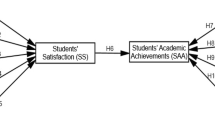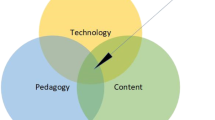Abstract
Transnational education (TNE) has been a growth area for UK universities over the last decade. The standard typology classifies TNE by the nature of the activity (i.e., distance learning, international branch campus, franchise, and validation). By analysing a large number of TNE partnerships around the world, this study reveals that the current typology has declining value because partnerships are becoming multidimensional and blurring the boundaries between one type and another. It draws on partnership theory and transaction cost analysis to develop a new risk-based typology, using six dimensions of a TNE partnership. The new typology provides a risk profile for a TNE partnership which identifies the sources of reputational risk to the home university.


Similar content being viewed by others
References
Altbach, P., & Knight, J. (2007). The internationalization of higher education: Motives and realities. Journal of Studies in International Education, 11(3–4), 290–305.
Beerkens, E. (2002). International inter-organisational arrangements in higher education: Towards a typology. Tertiary Education and Management, 8(4), 297–314.
Bennell, P., & Pearce, T. (2003). The internationalisation of higher education: Exporting education to developing and transitional economies. International Journal of Educational Development, 23(2), 215–232.
Bradley, M. (2007). North-South research partnerships: Challenges, responses and trends—A literature review and annotated bibliography. Working Paper 1, IDRC Canadian Partnerships Working Paper Series. Ottawa: International Development Research Centre. http://idl-bnc.idrc.ca/dspace/bitstream/10625/36539/1/127716.pdf. Accessed December 13, 2014.
Burgess, P., & Berquist, B. (2012). Cross-border delivery: Programs, programs, and providers. In D. K. Deardorff, J. Heyl, & T. Adams (Eds.), The SAGE handbook of international higher education (pp. 325–342). London: Sage.
Castle, R., & Kelly, D. (2004). International education: Quality assurance and standards in offshore teaching: Exemplars and problems. Quality in Higher Education, 10(1), 51–57.
C-BERT. (n.d.) Branch campus listing (Updated March 17, 2014). http://www.globalhighered.org/branchcampuses.php. Accessed March 28, 2014.
Coase, R. (1937). The nature of the firm. Economica, 4(16), 386–405. http://onlinelibrary.wiley.com/doi/10.1111/j.1468-0335.1937.tb00002.x/pdf. Accessed April 4, 2013.
Craft, A. (2004). The assessment of quality risks in collaborative provision. Quality in Higher Education, 10(1), 25–29.
De Wit, H. (2002). Internationalization of higher education in the United States of America and Europe: A historical, comparative, and conceptual analysis. London: Greenwood Press.
Drew, S., McCaig, C., Marsden, D., Haughton, P., McBride, J., McBride, D., et al. (2008). Trans-national education and higher education institutions: Exploring patterns of HE institutional activity. London: Department for Innovation, Universities and Skills.
Drew, S., Tang, N., Poole, G., & Willis, B. (2006). Trans-national education—UK higher education institutions’ response to increasing global demand: Summary report. Manchester: British Council.
Edwards, J., Crosling, G., & Edwards, R. (2010). Outsourcing university degrees: Implications for quality control. Journal of Higher Education Policy and Management, 32(3), 303–315.
Frank, F., & Smith, A. (2000). The partnership handbook. Minister of Public Works and Government Services, Canada. http://publications.gc.ca/collections/Collection/MP43-373-1-2000E.pdf. Accessed March 5, 2013.
Garrett, R. (2002). International branch campuses: Scale and significance. Redhill: Observatory on Borderless Higher Education. http://www.obhe.ac.uk/documents/view_details?id=574. Accessed September 20, 2012.
Garrett, G., & Verbik, L. (2004). Transnational delivery by UK higher education, part 1: Data and missing data. Redhill: Observatory on Borderless Higher Education. http://www.obhe.ac.uk/documents/view_details?id=63. Accessed June 6, 2012.
Global Alliance for Transnational Education. (1997). Certification manual. Cited in: Adams, T., 1998. The operation of transnational degree and diploma programs: The Australian case. Journal of Studies in International Education, 2(1), 3–22.
Gore, T. (2012). Higher education across borders: Models of engagement and lessons from corporate strategy. Redhill: Observatory on Borderless Higher Education. www.obhe.ac.uk/documents/download?id=895. Accessed August 20, 2012.
HEIDI. (n.d.) Higher education information database for institutions. https://heidi.hesa.ac.uk/home.aspx. Accessed March 28, 2014.
Henry, J. (2011). University of Wales abolished after visa scandal. http://www.telegraph.co.uk/education/educationnews/8843200/University-of-Wales-abolished-after-visa-scandal.html. Accessed January 17, 2014.
HESA. (n.d.) Free online statistics—Students & qualifiers. http://www.hesa.ac.uk/content/view/1897/239/. Accessed March 28, 2014.
House of Commons. (2005). Education and skills committee: UK e-University (third report of session 2004–05). http://www.publications.parliament.uk/pa/cm200405/cmselect/cmeduski/205/205.pdf. Accessed December 20, 2013.
Inkpen, A., & Beamish, P. (1997). Knowledge, bargaining power, and the instability of international joint ventures. Academy of Management Review, 22(1), 177–202.
Kinser, K., & Green, M. (2009). The power of partnerships: A transatlantic dialogue. Washington, DC: American Council on Education. http://www.eua.be/publications/reference-publications.aspx. Accessed December 15, 2013.
Knight, J. (2007). Cross-border tertiary education: An introduction. In Vincent-Lancrin, S. (Ed.) Cross-border tertiary education: A way towards capacity development. Organisation for Economic Cooperation and Development and The World Bank, 21–46.
Knight, J. (2011). Education hubs: A fad, a brand, an innovation? Journal of Studies in International Education, 15(3), 221–240.
Lane, J., & Kinser, K. (2012). International branch campuses: One definition to rule them all? http://chronicle.com/blogs/worldwise/international-branch-campuses-one-definition-to-rule-them-all/29051. Accessed February 6, 2013.
Larsen, K., Momii, K., & Vincent-Lancrin, S. (2004). Cross-border higher education: An analysis of current trends, policy strategies and future scenarios. Redhill: The Observatory on Borderless Higher Education. http://www.obhe.ac.uk/documents/view_details?id=49. Accessed October 19, 2012.
Lawton, W., & Katsomitros, A. (2012). International branch campuses: Data and developments. Redhill: Observatory on Borderless Higher Education. www.obhe.ac.uk/documents/download?id=894. Accessed August 22, 2012.
Long, F., & Arnold, M. (1995). The power of environmental partnerships. London: Dryden Press.
Maselli D., Lys, J.-A., & Schmid, J. (2006). Improving impacts of research partnerships. Swiss Commission for Research Partnerships with Developing Countries. Berne: KFPE GEOGRAPHICA BERNENSIA. www.kfpe.ch/download/KFPE_ImpactStudy-final.pdf. Accessed December 13, 2013.
Margerum, R. (2008). A typology of collaboration efforts in environmental management. Environmental Management, 41(4), 487–500.
McBurnie, G., & Ziguras, C. (2009). Trends and future scenarios in programme and institution mobility across borders. In Higher education to 2030 volume 2: Globalization. Paris: OECD, 89–108.
McQuaid, R. (2000). The theory of partnerships: Why have partnerships? In S. Osborne (Ed.), Public-private partnerships: Theory and practice in international practice (pp. 9–35). London: Routledge.
Middlehurst, R., Woodfield, S., Forland, H., & Fielden, J. (2009). Universities and international higher education partnerships: Making a difference. London: Million+. http://www.millionplus.ac.uk/research/index. Accessed August 24, 2012.
Moore, E., & Koontz, T. (2003). Research note—A typology of collaborative watershed groups: Citizen-based, agency-based, and mixed partnerships. Society & Natural Resources: An International Journal, 16(5), 451–460.
Muthusamy, S., & White, M. (2006). Does power sharing matter? The role of power and influence in alliance performance. Journal of Business Research, 59(7), 811–819.
Naidoo, V. (2009). Transnational higher education: A stock take of current activity. Journal of Studies in International Education, 13, 310–330.
Neave, G. (1992). Managing higher education international cooperation: Strategies and solutions. UNESCO. http://unesdoc.unesco.org/images/0009/000986/098679eb.pdf. Accessed May 30, 2013.
Observatory on Borderless Higher Education. (2007). A miscalculated level of risk? UNSW Asia announces its unexpected closure. http://www.obhe.ac.uk/documents/view_details?id=192. Accessed June 16, 2012.
Olsson, B. (2008). Symmetry and asymmetry in research partnerships: Lessons from 20 years’ experience. NORRAG News 41, December, 78–80. http://www.norrag.org/en/publications/norrag-news/online-version/the-new-politics-of-partnership-peril-or-promise/detail/symmetry-and-asymmetry-in-research-partnerships-lessons-from-20-years-experience.html. Accessed December 14, 2013.
Open University. (n.d.) Facts and figures. http://www.open.ac.uk/about/main/the-ou-explained/facts-and-figures. Accessed January 17, 2014.
Selin, S. (1999). Developing a typology of sustainable tourism partnerships. Journal of Sustainable Tourism, 7(3&4), 260–274.
Smith, J., & Wohlstetter, P. (2006). Understanding the different faces of partnering: A typology of public–private partnerships. School Leadership and Management, 26(3), 249–268.
Stella, A. (2006). Quality assurance of cross-border higher education. Quality in Higher Education, 12(3), 257–276.
University of Nottingham. (2010). Strategic plan 2010–15. http://www.nottingham.ac.uk/about/documents/universityofnottinghamstrategicplan2010-15.pdf. Accessed December 20, 2012.
Verbik, L., & Merkley, C. (2006). The international branch campus—Models and trends. Redhill: Observatory on Borderless Higher Education. http://www.obhe.ac.uk/documents/view_details?id=34. Accessed November 20, 2012.
Waddock, S. A. (1991). A typology of social partnership organizations. Administration and Society, 22(4), 480–515.
Waechter, B. (2000). Handbook on European associations in higher education: A practical guide to academic networks in Europe and beyond. Brussels: Academic Cooperation Association.
Wilkins, S., & Huisman, J. (2012). The international branch campus as transnational strategy in higher education. Higher Education, 64(5), 627–645.
Williamson, O. (1975). Markets and hierarchies: Analysis and antitrust implications: A study in the economics of internal organization. London: Collier Macmillan.
Yorke, M. (1993). Quality assurance for higher education franchising. Higher Education, 26(2), 167–182.
Ziguras, C., & McBurnie, C. (2008). The impact of trade liberalization on transnational education. In M. Wallace & L. Dunn (Eds.), Teaching in transnational higher education: Enhancing learning for offshore international students. Oxford: Routledge.
Author information
Authors and Affiliations
Corresponding author
Rights and permissions
About this article
Cite this article
Healey, N.M. Towards a risk-based typology for transnational education. High Educ 69, 1–18 (2015). https://doi.org/10.1007/s10734-014-9757-6
Published:
Issue Date:
DOI: https://doi.org/10.1007/s10734-014-9757-6




